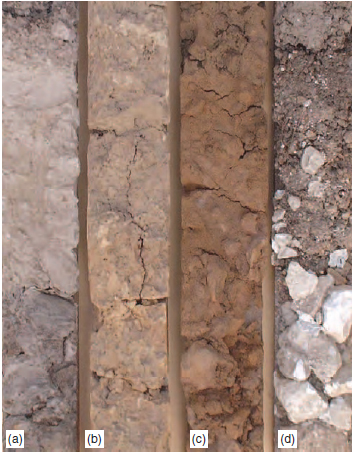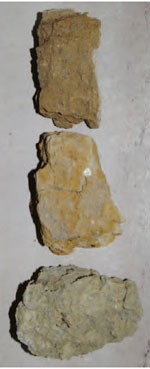Soils of the British Isles
Content
In the British Isles four main types of mineral soil are found; brown earths, gleys, rendzinas and podsols (see Figure 17.6). Peats develop in waterlogged conditions (see organic soils). Brown earth soils develop in the well-drained medium to heavy soils in the lowlands of the British Isles. They are associated with a climax vegetation of broad-leaved woodland especially oak, ash and sycamore, the roots of which have ensured that nutrients moving down the soil profile are captured and returned to the soil via the leaf fall. Surplus water does not accumulate and the soil remains aerobic for most of the year. The plentiful earthworms incorporate the deep litter layers. The resultant dark A horizon (‘topsoil’) rich in organic matter merges gradually into a bright brown and deep B horizon (‘subsoil’). The soil structures that develop in the surface layers are granular and rounded fine blocky in which there is an excellent balance of air and water and into which roots can readily penetrate. Brown earths are usually mildly acid (pH 5.5 to 6.5), but acid brown earths (pH 5.5 to 4.5) can develop on lighter textured soils in wetter areas (800–1000 mm rain per year) especially under beech or birch woodland. There is less earthworm activity, with a resultant reduced incorporation of organic matter down the profile. The soil structure is usually less satisfactory and clay particles that work their way down can form clay pans in the B horizon. These can be productive soils if ameliorated with lime and fertilizer (see Plant nutrition).
Ground water gleys develop where there is a permanent water table that is very near the surface of the soil, so that to lower the water table drainage has to be undertaken on a regional basis, e.g. Romney Marsh. Drainage pipes can only be used when the water can be run to a ditch with a water level below that desired in the field; for some areas this can only be achieved by maintaining an artificially low level by the use of pumps (powered in former times by windmills). Podsols (from the Russian ‘under-ash’) are strongly leached, very acid soils that develop on freely draining soils, such as coarse sands and gravels, commonly under heather or pine or spruce forest in high rainfall areas. Because of the high acidity levels, earthworms are absent so there is a build-up of the litter layer. Poorly decomposed organic matter that is not incorporated (a ‘mor’ humus) is characteristic of this soil type. Some of the organic matter combines with the iron in the top layers to form soluble compounds which are leached (‘podsolization’) to leave a grey (‘ash-like’) A horizon (all that remains are bleached sand grains). These compounds become insoluble again in the conditions that prevail in the B horizon, where organic matter accumulates to create a dark or black horizon below which is an iron rich red layer. The iron compounds that accumulate can form a strongly cemented ‘iron pan’. As a continuous pan that water (and roots) cannot penetrate is formed, a waterlogged area develops and peat can form at the surface. Podsols are prone to drought and are ‘hungry’ soils that require considerable ongoing inputs of lime and manure to make them productive. They are of little use in horticulture except for the growing of acid loving trees and shrubs. Rendzinas are very thin dark-brown, sometimes black, soils with a strong granular structure sitting directly on chalk or limestone. They are typical of the soils on the steeper slopes of chalk or limestone hills under grass. Shallow soils develop because of the continued erosion on the slopes, which also keeps these soils heavily charged with lime. Where the soils become deeper on the less severe slopes it is common for the A horizons to become acid, as the lime is leached downwards. They are well drained because of the slope and because of the porous nature of the underlying rock. Rendzinas are not suitable for most horticultural purposes because the high lime content causes induced nutrient deficiencies. Roots are severely restricted by the shallow soils and vulnerable to drought. |






